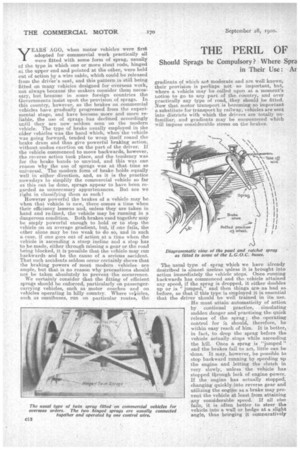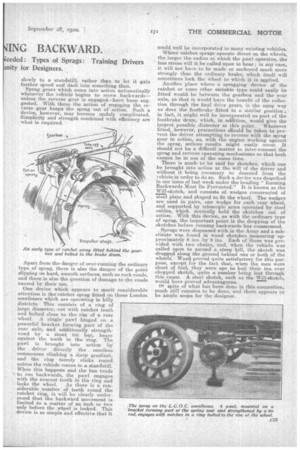THE PERIL OF ING BACKWARD.
Page 18

Page 19

If you've noticed an error in this article please click here to report it so we can fix it.
Should Sprags be Compulsory ? Where Spra in Their 'Use : Ar eeded : Types of Sprags : Training Drivers nity for Designers.
yEAR8 AGO, when motor Vehicles were first adopted for commercial work practically all were fitted with some form of sprag, usually of the type in which one or more stout rods, hinged at the upper end and pointed at the other, were held out of action by a wire cable, which could be released from the drWer's seat, and this pattern is still being fitted on many vehicles designed for overseas work, not always because the makers consider them neces:sary, but because in some foreign countries the Governments insist upon the provision of sprags. In this country, however, as the brakes on commercial vehicles have gradually progressed from the experimental stage, and have become more and more reliable, the use of sprags has declined accordingly until they are now seldom seenan the modern vehicle. The type of brake usually employed in the older vehicles was the band which, when the vehicle was going forward, tended to wrap itself round the brake drum and thus give powerful braking action, without undue exertion on the part of the driven If the vehicle commenced to move backwards, however, the reverse action took place, and the tendency was for the brake bands to unwind, and this was one reason Why the use of sprags was at that time so universal. The modern form of brake holds equally well in eitherdirection, and, as it is the practice nowadays to simplify the commercial vehicle so far as this can be done, sprags appear to have been regarded as unnecessary appurtenances. But are we right in classifying them as such?
However powerful the brakes of a vehicle may be, when that vehicle is new, there comes a time when their efficiency lessens and, unless they are taken in hand and re-lined, the vehicle•may be running in a dangerous condition. Both brakes used together may be. amply powerful enough to held or to stop the vehicle on an average gradient, hut, if .one fails, the other alone may be too weak to do so, and in such a. ease, if one goes out of action at a time when the vehicle is ascending a steep incline and a stop has to be made, either through missing a gear or the road being blocked, it is-possible that the vehicle may runbackwards and be the cause of a serious aocident. That such accidents seldom occur certainly shove that the braking powers of most modern vehicles, are ample, but that is no reason why precautions should not be taken absolutely to prevent the occurrence.
Re certainly consider that the fitting of efficient sprags should be enforced, particularly on passengercarrying vehicles, such as motor coaches 'and on vehicles operating in hilly country. Where velpicles, such as omnibuses, run on particular routes, the gradients of which are moderate and are well known, their provision is perhaps not so important, but, where a vehicle may be called upon at a moment's notiea to go to any part of the country, and over practically any type of road, they should be fitted. Now that motor transport. is becoming so important a substitute for transport by railway, vehicles are sent into districts with which the drivers are totally unfamiliar, and gradients may be encountered which will impose considerable stress on the brakes.
The usual type of sprag which we have already deseribed is almost useless nnless it is brought into action immediately the vehicle stops'. Once running backwards has commenced and the vehicle attained any speed, if the sprag is dropped, it either doubles up or is "jumped," and then things areas bad as before, so that if this type is employed it is essential that the driver should be well trained in its use. He must attain automaticity of action by continual practice, simulating sudden danger and practising the quick release of the sPrag ; the operating control for it should, therefore, be within easy reach of him. It is better,. in fact, to drop the sprag before the vehicle actually stops while ascending the hill. Once a sprag is "jumped" and the brakes fail' to act, little can be -done. It may, however, be possible to stop backward running by speeding up the engine and letting the clutch in very slowly, unless the vehicle has stopped through lack of engine power. If the engine has actually stopped, changing quickly into reverse gear and utilizing the engine as a brake may prevent the vehicle at least from attaining any considerable speed. If all else fails, it is often better to steer the vehicle into a wall or hedge at a slight angle, thus bringing it comparatively slowly to a standstill, rather than to let it gain further speed and dash into something then. . Spraggears which come into action automatically whenever the vehicle begins to move backwards— unless the reverse gear is engaged—have been suggested. With these the action of engaging the reverse gear keeps the sprag out of action. Such a device, however, may become unduly complicated. Simplicity and strength combined with efficiency are what is required.
Apart from the danger of over-running the ordinary type of sprag, there is also the danger of the point slipping on hard, smooth surfaces, such as rock roads, and there is also the question of damage to the roads caused by their use.
One device which appears to merit considerable attention is the ratchet sprag fitted on those London omnibuses which are operating in hilly districts. This consists of a ring of large diameter, -cut with ratchet teeth and bolted close to the rim of a rear wheel. A single pawl hinged on a powerful bracket forming part of the rear axle, and additionally strengthened by a stout tie bar, bears against the teeth in the ring. The pawl is brought into 'action by" the driver directly the omnibus commences climbing a steep gradient, and the ring merely clicks round unless the vehicle comes to a standstill. When this happens and the bus tends to run backwards, the pawl engages with the nearest tooth in the ring and
locks the wheel. As there is a considerable number of teeth round the ratchet ring, it will be clearly understood that the backward movement is limited to a matter of an inch or two only before the wheel is locked. This device is so simple and effective that it
could well be incorporated in many existing 'Vehicles.
Where ratchet sprags operate direct on the wheels, the larger the radius at which the pawl operates, the less stress will it be called upon to bear ; in any case, it will not have to he made or anchored much more strongly than the ordinary brake, which itself will sometimes lock the• wheel to• which it is applied.
Another place where a spragging device of the ratchet or some other suitable type could easily be fitted would be between the gearbox and the rear axle, so that it would have the benefit of the reduction through the final drive gears, in the same way as does the footbrake fitted in a similar position ; in fact, it might well be incorporated as part of the footbrake drum, which, in addition, would give the largest possible diameter at this point.. Wherever fitted, however, precautions sliould be taken to prevent the driver attempting to reverse with the sprag gear in action, as, with the engine working against the sprag, serious results might easily occur. It should not be a difficult matter to inter-connect the
sprag and reverse operating mechanisms so that both cannot be in use at the same time.
There is much to be said for skotches, which can be brought into action at the will of the driver and without it being necessary to descend from the vehicle in order to do so. Such a device was dewribed in our issue of last week under the heading " Running Backwards Must Be Prevented." It is known as the Will-sketch, and consists of wedges constructed of steel plate and shaped to fit the wheel. The wedges are used in pairs, one wedge for each rear wheel, and supported by telescopic arms operated by steel cables, which normally hold the sketches out of action. With this device, as with the ordinary type of sprag, the important point is the dropping of the sketches before running backwards has commenced.
Sprags were dispensed with in the Army and a substitute was found in wood skotdies measuring approximately 6 ins. by 9 ins. Each of these was provided with two chains„ and, when the vehicle was called upon to ascend a steep hill, the sketch was dragged along the .ground behind one or both of the wheels. Wood proved quite satisfactory for this purpose, except for the fact that, when the men were short of fuel, they were apt to boil their tea over chopped skcitch, quite a number being lost through this cause. A steel sketch, such as the Will-sketch, would have proved advantageous.
m spite ,ot what has been done in this connection, much still remains to be done, and there appears to be ample scope for the designer.






































